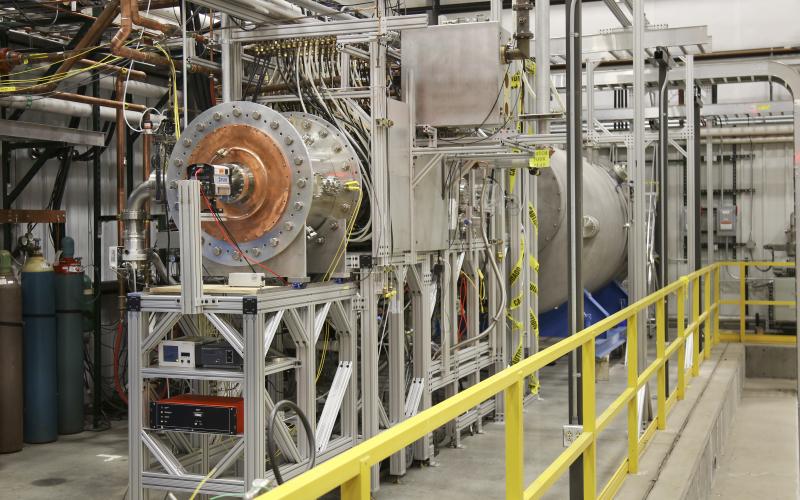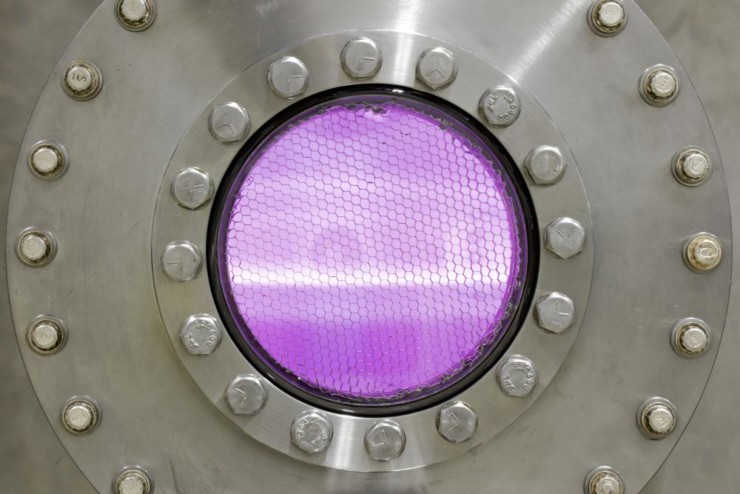
Oak Ridge National Laboratory has been chosen as the site of an experimental facility to test materials that would withstand the harsh conditions of the plasmas created in fusion devices, which, researchers hope, could eventually provide carbon-free energy to people around the world.
The proposed facility, the Materials Plasma Exposure Experiment facility, or MPEX, has an estimated cost range between $87 million and $175 million. It would be in an existing facility in an area at ORNL known as the Energy Systems Test Complex.
Fusion devices would use the same reactions that power the sun. Temperatures inside a fusion reactor could reach millions of degrees.
Scientists are studying materials that could withstand the conditions inside fusion reactors by exposing them to prototypical plasma conditions. Plasma, the heated matter created in a fusion device, has high-energy neutrons, electrons, and ions. MPEX would study materials that face the plasma. Finding materials capable of withstanding the harsh environment remains a major hurdle to using fusion to produce energy.
A critical decision for the MPEX facility was completed in early February by the U.S. Department of Energy. ORNL is a DOE Office of Science lab. The critical decision, CD-1, is the second step in the five-step process that DOE uses to manage projects. The CD-1 decision included an alternative selection and a cost range.
ORNL was selected because of its fusion materials program and wide-ranging nuclear facilities management and capabilities, among other attributes, and the lab is the site of the Proto-MPEX. That is the forerunner facility used to develop the technology and design for MPEX.

There are currently no materials that can withstand the harsh conditions inside a future fusion power plant, including plasma and neutrons. MPEX is expected to help the fusion researchers develop those materials.
In 2016, MPEX program manager Juergen Rapp said developing materials for a fusion reactor is like developing a heat shield for the space shuttle, but the heat fluxes encountered by a re-entry vehicle are nothing compared to the fluxes that materials will experience inside a fusion reactor.
The materials will be constantly exposed to fusion plasmas reaching 10,000 to 100,000 degrees Kelvin (roughly 18,000 to 180,000 degrees Fahrenheit) and high-energy neutrons, ions, and electrons that damage and degrade materials.
In one milestone, ORNL said in October that researchers at Proto-MPEX, which creates a linear-shaped plasma, were able to raise a plasma temperature to achieve heat fluxes approaching 10 megawatts per square meter, similar to what is expected in the International Tokamak Experimental Reactor, or ITER. That’s the world’s largest fusion experiment, and it is under construction in southern France.
ORNL has said the Proto-MPEX was designed to test materials using a powerful plasma source only in brief bursts. MPEX could run longer, 24 hours a day, seven days per week, for possibly two weeks at a time to expose materials to plasma and see how they hold up, Rapp said in 2016.
The facility could test materials that have been developed by ORNL’s Materials Science and Technologies Division. Besides being tested at MPEX, the materials could also be tested by exposing them to high neutron fluxes (flows) at ORNL’s High Flux Isotope Reactor.
ORNL’s involvement in fusion research has included leading the U.S. ITER project office and leading the Innovation Network for Fusion Energy (INFUSE) program, which was established by DOE’s Fusion Energy Sciences program in 2019. ORNL oversees U.S. research and development contributions to ITER, and the lab has a fusion science program that is expected to pursue challenges beyond ITER, challenges that will need to be addressed to bring fusion power to the electrical grid.
Other challenges being worked on at ORNL include the fusion energy fuel cycle, improved modeling of fusion devices, and improved techniques for controlling the plasma. The lab collaborates with other fusion researchers across the country, including in industry and at other national laboratories.
Fusion happens when the nuclei of lighter atoms join under extraordinarily high temperatures to create a heavier nucleus, releasing energy. The hot, fused atoms form a plasma that is confined by high magnetic fields in an experimental vessel called a tokamak designed to withstand conditions hotter than the sun. But instabilities can occur in such an extreme environment. Researchers have been building the scientific basis for nuclear fusion for decades as an energy source that could generate electricity. Current nuclear power reactors use fission. While fusion combines atoms, fission splits them.
Learn more about fusion energy and MPEX at ORNL here.

Leave a Reply